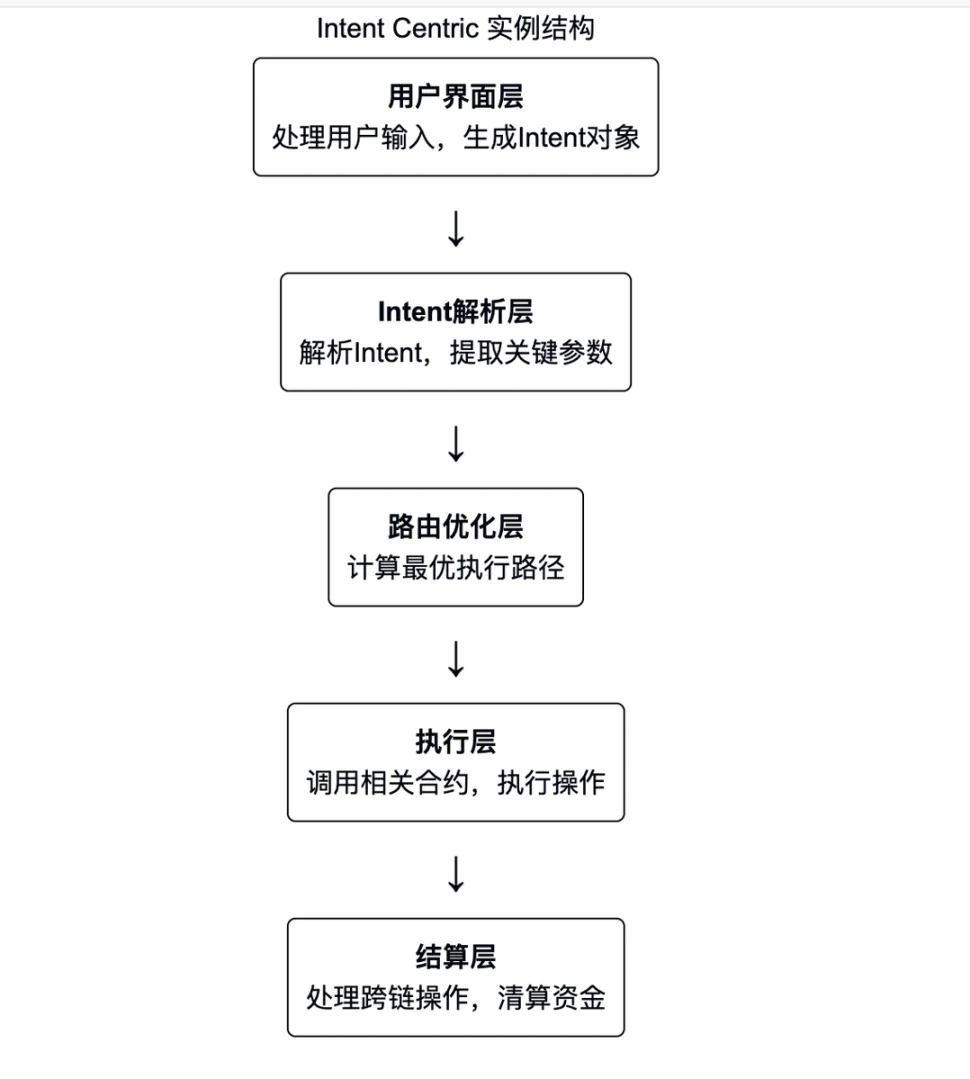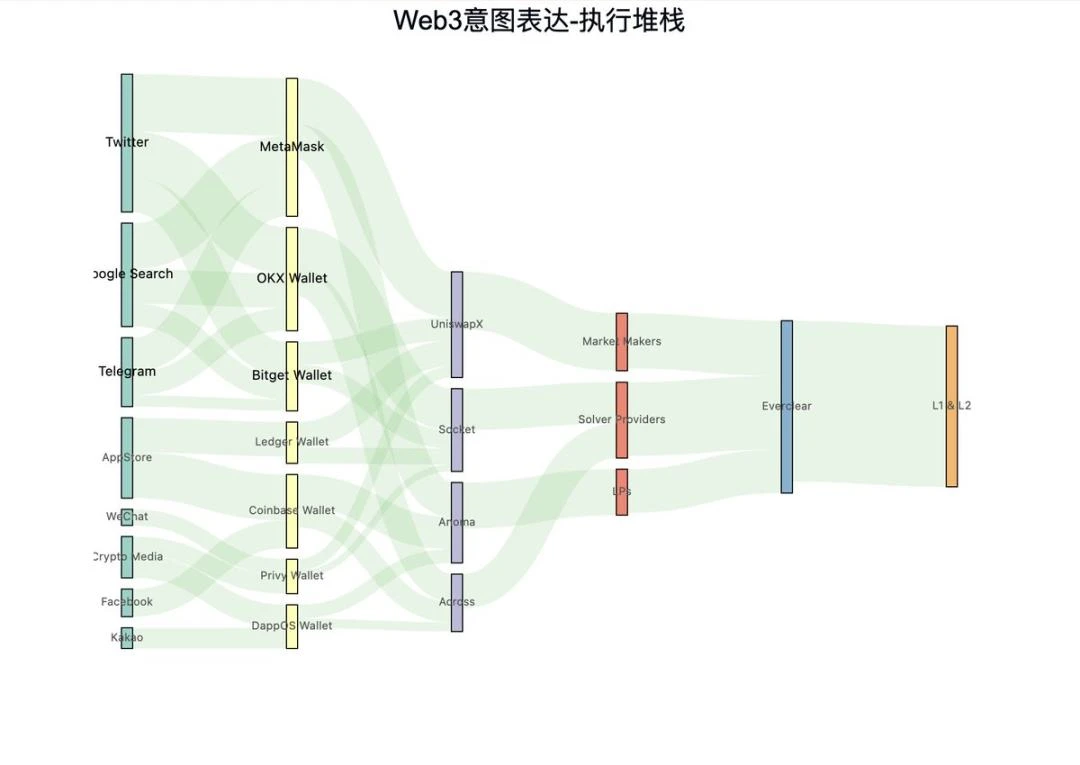In-depth analysis of Intent Centric primitives and their instantiation
Original author: NingNing
After being proposed by Paradigm, the Intent Centric primitive became a hot topic in the industry last year. However, the wording of this new primitive is a bit abstruse, and many people in the market have some difficulty understanding it.
In essence, the Intent Centric primitive is a computing paradigm that abstracts user intent and encapsulates complex execution logic. It decouples user needs from underlying execution by introducing the Intent Layer as an intermediate abstraction layer.
Or is it a lack of understanding? Here is a more down-to-earth example:
Traditional on-chain operations: call function X of contract A to obtain token B, then call the cross-chain bridge contract C to transfer B to chain D, and finally call DEX contract E on chain D to exchange it for token F.
Intent Centric method: Exchange A for F on chain D.
Do you see the difference? The Intent Centric approach abstracts complex multi-step operations into a single intent, greatly simplifying the user interaction model.
Why Intent Centric?
Why are VC institutions and developers excited about this new primitive at its inception? This is because the Intent Centric primitive is not just a technical paradigm innovation, it represents the beginning of Web3s transformation from mechanism design to experience design, and it has the potential to reshape the entire blockchain computing model and pave the way for true large-scale adoption.
Intent Centric primitives have revolutionary effects in the following five aspects:
Computational complexity optimization: By combining multiple steps into a single intent, global optimization can be performed at the execution level. This not only reduces gas consumption, but also significantly improves execution efficiency.
State space compression: In traditional methods, each intermediate step will generate a state change on the chain. The Intent Centric mode can compress multiple state changes into a single state transition, greatly reducing the storage pressure on the chain. This is especially important for public chains like Ethereum that have serious state explosion problems.
Improved parallelism: The abstract nature of Intent allows the system to perform more flexible scheduling at the execution level. For example, cross-chain Intents from multiple users can be batched, thereby improving overall throughput.
Enhanced interoperability: As a standardized abstraction, Intent can greatly promote interoperability between different protocols. This lays the foundation for building a truly cross-chain and cross-protocol ecosystem. The practice of UniswapX shows that Intent-based routing can seamlessly integrate the liquidity of multiple DEXs and provide users with better execution prices.
Improved security: By encapsulating complex logic in an auditable Intent executor, the security risks caused by direct user operations can be greatly reduced. Data from CoW Swap shows that after adopting the Intent mode, the losses caused by user operation errors have been reduced by more than 90%.
Instantiation of Intent Centric Primitive
At present, the instantiation application cases of Intent Centric primitives include (but are not limited to):
dappOSs Intent Assets: This is a typical state polymorphic application. Intent Assets are logically represented as a single asset, but may be physically distributed on multiple chains. When the user expresses the intention to use, the system automatically performs the optimal cross-chain routing and aggregation. This design not only optimizes the efficiency of capital utilization, but also provides users with a seamless cross-chain experience. Technical highlights: The ZK-based state proof mechanism is adopted to ensure the security and low latency of cross-chain operations.
Renzos Restake from Anywhere: This is an innovative application of Intent Centric in the field of staking. By abstracting the staking operation into Intent, Renzo successfully solved the liquidity and composability issues of ETH staking. Core innovation: Introduced a new staking token standard that allows staking Intents to flow freely between different chains, thus realizing true cross-chain staking.
Everclears clearing layer: Everclear cleverly solves the problem of liquidity dispersion in cross-chain operations by introducing the Intent clearing layer. It virtualizes the liquidity on multiple chains into a global liquidity pool, greatly improving the efficiency of capital utilization. Technical highlights: It uses innovative multi-party computing (MPC) technology to coordinate cross-chain operations, which not only ensures security, but also significantly improves execution efficiency.
CoW Swaps batch auction mechanism: CoW Swap cleverly solves the MEV (maximum extractable value) problem in DEX by introducing a batch auction mechanism, while greatly improving transaction efficiency. This is a revolutionary application of the Intent Centric primitive in the field of decentralized trading. Core innovation: a) Batch order matching: CoW Swap collects users transaction intentions (Intents) in batches instead of executing them immediately. This allows the system to find the best match in a larger order pool, greatly improving the probability of transaction and price optimization space. b) Off-chain solution, on-chain settlement: Order matching is carried out off-chain, and only the final settlement results are on-chain. This design greatly reduces gas costs while improving the scalability of the system. According to CoW Swap data, this method can reduce gas costs by up to 90%. c) Competitive Solver mechanism: CoW Swap introduces a Solver competition mechanism, allowing multiple Solvers to compete to provide the best order matching solution. This not only improves matching efficiency, but also introduces decentralized elements and enhances the robustness of the system. d) MEV protection: Through batch processing and off-chain matching, CoW Swap effectively eliminates MEV attacks such as front-running and clamp trading that are common in traditional DEX.
From the above application examples, we can summarize the general architecture of the instantiation of Intent Centric primitives:
User interface layer:
Function: Receive user input and generate standardized Intent objects.
Example: CowSwap: Users specify the tokens and quantities they want to swap.
UniswapX: Users choose input and output tokens, as well as slippage tolerance.
DappOS: Users express their intention to use Intent Assets, such as cross-chain transfers or transactions.
Intent parsing layer:
Function: Parse the Intent object and extract key parameters such as token address, quantity, price limit, etc.
Example: CowSwap: Parse the users transaction request and determine the transaction pair and quantity.
UniswapX: Analyze users’ trading intentions, including token pairs and price requirements.
DappOS: Parse the users Intent Assets usage request and determine the operation type and parameters.
Route optimization layer:
Function: Calculate the optimal execution path based on the parsed Intent.
Example: CowSwap: Uses a batch auction mechanism to find the best matching solution.
UniswapX: Calculates the optimal token swap path, which may involve multiple DEXs.
DappOS: Calculate the best cross-chain path and execution strategy for the use of Intent Assets.
Execution layer:
Function: Call related smart contracts to perform operations based on the optimized path.
Example: CowSwap: Execute batch orders through the selected solver.
UniswapX: Calls the selected DEX contract to perform token swaps.
DappOS: Executes related operations of Intent Assets, such as cross-chain transfers or transactions.
Settlement layer:
Function: Process cross-chain operations, clear funds, and ensure that all participants receive the assets they deserve.
Example: EverClear: As a dedicated clearing layer, it coordinates the flow and settlement of funds between different chains.
DappOS: Handles the settlement and synchronization of Intent Assets between different chains.

These projects abstract complex on-chain operations into simple user intentions, greatly simplifying user interactions. They are also highly flexible and can adapt to different application scenarios and user needs.
On-chain data display and hidden layer 0
Unfalsifiable truth is not science, and primitives that cannot achieve PMF are just empty words.
Looking at the Dune data dashboards of the above four examples, we can see that Cowswap’s data stands out, Renzo’s “Restake from Anywhere” performance is relatively bright, and the on-chain data of DappOS and EverClear are relatively average at present.

Cowswap solves the real pain points of on-chain transaction users in terms of MEV resistance, gas-free transactions, advanced orders, etc. You only need to sign, and you don’t need to spend gas fees to Approve and Swap to complete a transaction. Of course, you still need to pay the handling fee.
Renzos Restake from Anywhere solves the pain points of interaction complexity and additional cross-chain operation costs when Wrap ETH on other L2/L1 participates in Restaking points Farming.
DappOSs Intent Assets solves the needs of users who want native on-chain returns while maintaining high liquidity and lossless interchangeability of assets.
EverClears clearing layer provides a new underlying clearing infrastructure for protocols in the era of chain abstraction, solving the solvers pain points such as rebalancing, programmable clearing, and permissionless chain expansion.

The differences in the on-chain data performance of these examples lie in the differences in the layers and competitive environments they choose in the Web3 intent-execution stack.
Web3 Intent Expression - The execution stack can be divided into 5 layers:
Web3 Intent Expression - Layer 0 entry layer of the execution stack: Twitter, Google Search, Telegram, AppStore, Crypto vertical media, Facebook, Kakao, WeChat, etc.
Web3 Intent Expression - 1st layer wallet account layer of the execution stack: MetaMask wallet, OKX wallet, Bitget wallet, Coinbase wallet, Ledger wallet, DappOS wallet, Privy wallet, etc.
Web3 Intent Expression - 2-layer intent expression layer of the execution stack: Cowswap, UniswapX, Anoma, Socket, Across, etc.
Web3 Intent Expression - 3 layers of the execution stack Intent execution layer: market makers, LPs, solver service providers
Web3 Intent Expression - 4 Clearing Layers of the Execution Stack: Everclear
Web3 Intent Expression - 5 Settlement Layers of the Execution Stack: L1L2
Currently, Cowswap and Renzo, which are positioned at the second layer, are doing well with their Restake from Anywhere. Everclear, which is positioned at the fifth layer, is still in the early stages of its growth curve as a newly launched middleware. DappOS, which is positioned at the first, second, and third layers, is facing fierce competition from both sides. Moreover, as a latecomer, it seems unable to grab food from giants such as MetaMask, OKX Wallet, and Bitget Wallet with its own Intent Assets and Solver network.
In particular, Layer 0 of the Web3 Intent Expression Execution Stack is invisible in the current Intent Centric instance design architecture. However, as the entrance to the Web3 ecosystem, Layer 0 not only provides a channel for user acquisition, but also shapes user perception, affecting product positioning and market competition.
For the Intent Centric example project, it is advisable to learn from the idea of Solana Blinks and move the intent expression from layer 2 to layer 0. Establishing direct contact with users will be the key to achieving and maintaining PMF.
Future Outlook: Potential Revolution of Intent Centric Paradigm
In addition to existing use cases, the Intent Centric paradigm has the following untapped potential:
Computing paradigm shift: The shift from imperative to declarative may completely change the way smart contracts are written. Imagine that in the future, DApp developers may only need to describe the expected results instead of detailed execution steps.
New model for inter-chain state synchronization: Intent may become a new carrier for state synchronization between different chains, laying the foundation for true interoperability. This may lead to a shift from single-chain centralization to multi-chain collaboration.
AI-driven intent optimization: Combined with the Large Language Model (LLM) technology, AI agents that can understand natural language intents and automatically optimize execution paths may appear in the future. This will further lower the threshold for using Web3.
Decentralized Intent Marketplace: As the standardization of Intents progresses, we may see the emergence of decentralized markets dedicated to matching and executing Intents. This will create new opportunities for arbitrageurs and market makers.
Original link
Disclaimer: The content of this article solely reflects the author's opinion and does not represent the platform in any capacity. This article is not intended to serve as a reference for making investment decisions.
You may also like
Enjoy daily zero-interest spot margin trading — Trade to win up to 1000 USDT!
NODEUSDT now launched for futures trading and trading bots
HFTUSDT now launched for futures trading and trading bots
FRAGUSDT now launched for futures trading and trading bots
